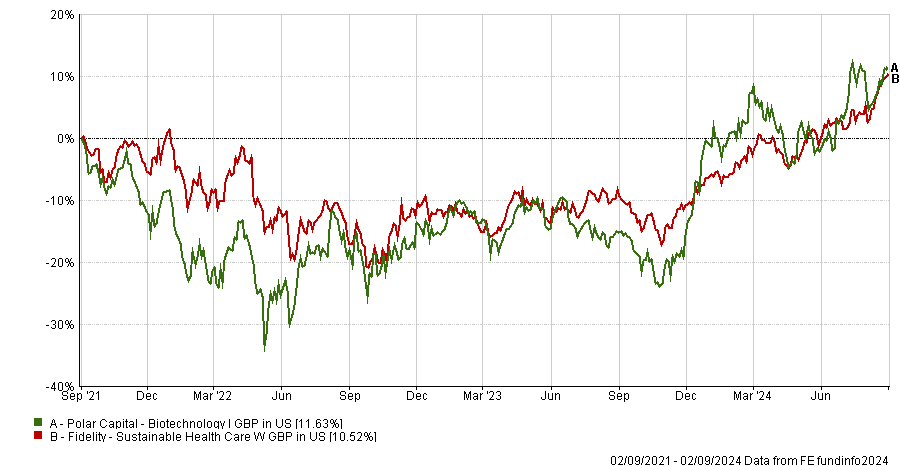If 2023 represented a record year for innovation in the healthcare sector as the US Food and Drug Administration approved 55 novel drugs, a 50% jump from the number of approvals in 2022, this has not been reflected in its performance.
Healthcare stocks in 2023 materially lagged the broader MSCI World index, which was up 24% compared to just 4% from the MSCI World Healthcare index as the sector has continued to struggle to live up to the high bar it set during the pandemic.
This is especially true in the case of biotechnology stocks, a sub-sector of healthcare, as the S&P Biotechnology Select Industry index has yet to recover its highs of 2021, however there are some reasons to be optimistic.
The most obvious reason is the looming cuts by the Fed to interest rates with biotechnology stocks in fact already experiencing a brief surge towards the end of last year as investors bet the Fed would start to trim in early 2024.
Of course that enthusiasm waned during the first half of this year as higher-than-expected inflation prints in the early months of the year caused central banks to hold off cutting rates, although with inflation now trending consistently lower, the Fed is finally poised to begin cutting.
At the same time, low valuations remain an important tailwind and this is true of the broader healthcare sector as well, where valuations in the sector are now at discounts to their history and to the broader market.
Against this background, Darius McDermott, managing director at Chelsea Financial Services, chose the Fidelity Sustainable Healthcare fund and the Polar Capital Biotechnology fund for this week’s head to head.
| Fidelity | Polar Capital | |
| Size | $2.07bn | $1.97bn |
| Inception | 2014 | 2013 |
| Managers | Alex Gold | David Pinniger |
| Three-year cumulative return | 10.52% | 11.63% |
| Three-year annualised return | 3.26% | 3.95% |
| Three-year annualised alpha | 3.93 | 5.25 |
| Three-year annualised volatility | 15.37 | 21.87 |
| Three-year information ratio | 0.61 | 0.20 |
| FE Crown fund rating | *** | ***** |
| OCF (retail share class) | 1.05% | 1.12% |
Investment approach
Polar Capital manager, David Pinninger, divides the sector into a number of groups including those with diversified earnings, revenue growth, those in clinical development, those with technology platforms and research pools and diagnostic companies.
Pinninger aims to ensure that the key themes in biotechnology are given the appropriate exposure and the fund’s allocations are filled with ideas generated from the healthcare team along with industry sources including specialist brokers and analysts.
Meanwhile, Fidelity fund manager Alex Gold casts his net wider by looking at the whole healthcare sector. Gold looks for three main characteristics in a company, namely quality, visibility and sustainability. He aims to find businesses with high and sustainable returns on invested capital as well as companies that could materially improve their returns.
“All of this is reflected in the Polar Capital fund being the more volatile of the two in the past three years. I’d see Polar Capital as a multi-cap offering, with a blended (with a leaning to growth) investment style, while Fidelity is a large-cap blended portfolio.”
darius mcdermott, chelsea financial services
When constructing a portfolio, Gold considers growth and valuation metrics, company financials, return on capital, cash flows and other measures as well as company management, industry, economic conditions and other factors. McDermott notes that the company makes big active calls, for example not holding Johnson & John or Novartis.
Beyond the fact that the Polar Capital fund invests just in biotech and the Fidelity fund invests in the broader healthcare sector, McDermott notes that the biggest difference is that the Polar Capital fund has a roughly 50:50 split between large and small and mid-cap holdings, whereas over 90% of the Fidelity fund is in large-cap holdings.
“All of this is reflected in the Polar Capital fund being the more volatile of the two in the past three years. I’d see Polar Capital as a multi-cap offering, with a blended (with a leaning to growth) investment style, while Fidelity is a large-cap blended portfolio,” said McDermott.
Geographic allocation:
| Fidelity | Polar Capital | ||
| USA | 64.3% | USA | 64.1% |
| Denmark | 9.2% | Netherlands | 9.2% |
| UK | 6.8% | Denmark | 7.2% |
| Switzerland | 6.1% | Sweden | 4.5% |
| France | 3.9% | UK | 3.7% |
| Ireland | 3.7% | Canada | 3.3% |
| Belgium | 1.7% | Switzerland | 2.5% |
| Japan | 1.3% | Belgium | 1.7% |
| Ireland | 1.3% | ||
| Germany | 1.3% | ||
| France | 0.9% |
Top five holdings:
| Fidelity | Weighting | Polar Capital | Weighting |
| UnitedHealth Group | 9.5% | Argenx | 6.6% |
| Novo Nordisk | 6.6% | Amgen | 6% |
| Boston Scientific Corp | 6.1% | Zealand Pharma | 5.8% |
| Eli Lilly & Co | 6.1% | Blueprint Medicines Corp | 4.6% |
| AstraZeneca | 5% | Vertex Pharmaceuticals | 4.5% |
Performance

McDermott notes that unsurprisingly the Polar Capital fund is more volatile and is likely to have strong bouts of performance tied to stock selection. He notes that the Polar Capital fund has produced a positive return in seven of the past 10 full calendar years, while it has outperformed the Nasdaq Biotechnology index in each of the past 10 full calendar years.
He notes that the fund’s strongest years came in 2014, 2019 and 2020, while 2022 was more challenging.
Meanwhile, McDermott notes that since Gold took over management of the Fidelity fund in 2018, it also has had an impressive record, losing money only in 2022. Its strongest years were 2021 and 2019, while returns have been fairly consistent on the whole.
Discrete calendar year performance
| Fund | YTD* | 2023 | 2022 | 2021 | 2020 |
| Fidelity | 14.8% | 0.97% | -3.33% | 24.68% | 8.45% |
| Polar Capital | 10.29% | 9.33% | 4.55% | 5.64% | 36.48% |
Manager review
McDermott nots that the Polar Capital fund is well-resourced with seven sector specialists with 135 years of combined experience.
Pinninger has more than two decades’ experience in the investment industry, most of which has been focused on healthcare. He joined Polar Capital in 2013 and beforehand worked at SV Life Sciences as a portfolio manager. He has also worked at venture capital firm Abingworth as a biotech analyst and at Morgan Stanley as an analyst.
McDermott notes that Fidelity has huge resources in healthcare as one of the largest asset managers globally. Gold joined Fidelity from PwC in 2010 and initially covered energy before switching his focus to healthcare four years later.
Conclusion
McDermott states that it is difficult to make a call on either of the funds given that a lot of it comes down to risk appetite.
“The Polar Capital Biotechnology fund is riskier, but the managers are excellent and have demonstrated an ability to find the right long-term businesses to own, in a growing area of the market. They are one of a small handful of market-leading biotech teams in the industry. You just have to be prepared for bumps in the road alongside strong periods of growth,” he said.
“The Fidelity fund is going to be the steadier of the two, given its focus on large-cap, quality businesses – and that is supported by its performance.”
“It comes down to what you are looking for really. You’d expect stronger long-term growth from the Polar Capital fund, but consistency from Fidelity, with less volatility. The blended argument is particularly strong for those who feel healthcare is a dominant long-term megatrend from here.”

















